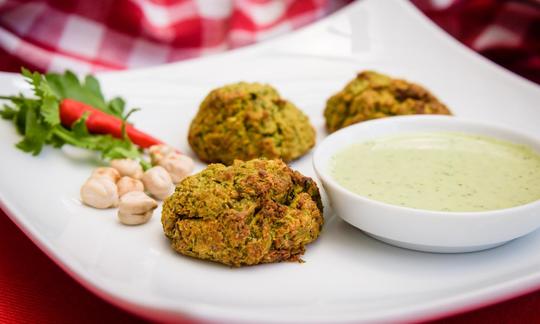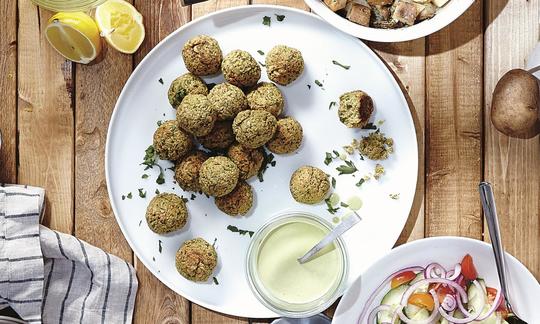Table of contents
The preparation of falafel goes back a long way in history. As a protein-rich, meat-free alternative, they are very popular around the world today. When buying, make sure they are organic.
Use in the kitchen
Falafels are an integral part of the cuisines of the Near and parts of the Middle East and North Africa. In Israel, this meat-free source of protein, which is also becoming increasingly popular in Europe, is even a national dish. As the balls are naturally vegan, they are particularly popular with vegetarians and vegans. The basic ingredients are pureed broad beans (especially in Egypt), chickpeas or a combination of both, although the chickpea version is much more popular in Europe. Falafels have a slightly nutty and aromatic taste. They are crispy on the outside and juicy on the inside. The taste is determined by various spices and herbs that are mixed into the mixture. Typical spices for falafels are coriander, parsley, cumin, garlic, onion, salt andpepper. Baking powder is usually added. The chickpeas give falafels their characteristic nutty taste. The herbs and spices provide the aromatic aroma. Onions and garlic give falafels a slight spiciness and baking powder ensures a crispy crust. In addition to preparation with fresh ingredients, ready-made mixes and "ready-made" falafels are also available, which you only have to heat up.
Is baked falafel healthier than fried? Many methods of preparation, especially those in street food, involve frying falafel. Frying in a deep fryer or a pot of boiling oil makes it easier to give the balls a slightly crispier consistency. However, falafel can also be prepared in the oven. This option is not only suitable for those who don't have a deep fryer, but is also the fat-free and healthier alternative. Although chickpeas have a low fat content and are cholesterol-free, they absorb a considerable amount of fat during the frying process. Baking in the oven is an efficient way to reduce the high fat content. Due to the way they are prepared, falafel are never raw.
The baked falafel is served either as finger food or as part of a main course; often with hummus, tahina (sesame sauce), salad, pickled vegetables such as eggplant, carrots or sweet peppers and pita bread. Roast potatoes, cucumber salad and basil-lemon-cashew dressing or a simple vegan yoghurt dip with mint or tzatziki (vegan) are also suitable as a side dish. Cold salads made from cooked bulgur or rice are also popular. At the numerous food stalls, the balls are often eaten in flatbread or a wrap. The spice sumac is also often used.
prepare
You can your own falafels easily and deliciously according to the recipe we published: " Baked green falafels according to Terry Hope Romero ".
Vegan recipe for a simple falafel bowl
Ingredients (for 4 people): Falafel (organic) or according to recipe, 1 iceberg lettuce (raw), 250 g cherry tomatoes (raw), 1 cucumber (raw), 1 red onion (raw), 10 g green mint (or peppermint). For the dressing: 1 lemon, 4 tbsp rapeseed oil (cold-pressed), 1-2 tbsp agave syrup, 2-3 tbsp water, salt andpepper.
Preparation: Prepare the falafels according to the recipe or baking instructions. Wash and clean the iceberg lettuce and chop or tear into small pieces. Wash and halve the tomatoes. Wash and chop the cucumber. Cut the onion into fine strips. Wash the mint, shake dry and chop roughly. For the dressing, halve the lemon and squeeze out the juice. Mix the lemon juice with the rapeseed oil, agave syrup, water, salt and pepper (to taste). Mix the lettuce, tomatoes, cucumber, mint and onion with the dressing and season to taste. Arrange the vegan falafels next to the salad and serve.
Vegan recipes with falafel can be found under the note: " Recipes that have the most of this ingredient ".
| Not only vegans or vegetarians should read this: Vegans often eat unhealthily. Avoidable nutritional errors. |
Purchasing - Storage
Information on purchasing and storing the ingredients for fresh falafels can be found directly in the linked recipe in the chapter on making your own. Ready-made falafels can be found all year round in health food stores and organic shops, at major retailers such as Coop, Migros, Denner, Spar, Aldi, Lidl, Rewe, Edeka, Hofer, Billa, and in organic quality in organic supermarkets such as Denn's Biomarkt and Alnatura. However, these can be pre-fried. According to our research, Volg does not stock any falafels. Ready-made dry falafel mixes are also available online or in health food stores. In addition to broad bean or chickpea flour (or groats), salt, onion powder and garlic powder, these also contain dried spices such as parsley, cumin, coriander and (white) pepper. In addition, raising agents such as baking soda or baking powder are usually added to the ready-made mixes.
The availability of falafel varies depending on the size of the store, catchment area, etc. Our recorded food prices for the DA-CH countries can be found above under the ingredient image - and by clicking on them you can see their development at different suppliers.
Storage tips
If you make your own falafel dough, you can store it in the refrigerator for up to 5 days, sealed tightly, without any major loss of flavor.
Ingredients - Nutritional values - Calories
The falafel nutrients vary depending on the composition and method of preparation. For this ingredient, we are following Terry Hope Romero's recipe.
100 g of falafel provide 273 kcal of energy. They contain 11 g of fat and 37 g of carbohydrates, of which 7 gare fiber. Does the falafel contain protein? 100 g of the balls contain 10 g of protein.
The folate content is 232 µg/100g. This covers 116% of the daily requirement. White short grain rice (231 µg/100g) and red lentils (204 µg/100g) have similar values. Good sources of folate are mainly pulses, such as mung beans (raw: 625 µg/100g, cooked: 159 µg/100g) orchickpeas (raw: 557 µg/100g, cooked : 63 µg/100g). 1
100 g of falafel contains 1.3 mg of manganese (67% of the daily requirement). Raw buckwheat and wild rice contain the same amount. Manganese is widespread in plant foods, especially in the germ and outer layers of grains. Larger amounts are found in wheat germ (13 mg/100g) and oat flakes (3.6 mg/100g). 1
Vitamin K is present at 40 µg/100g (54% of the daily requirement). Lupine flour contains a similar amount of the vitamin (43 µg/100g). Good sources of vitamin K can be found in green vegetables and salad, among other things. Swiss chard (830 µg/100g) and kale (705 µg/100g) contain particularly high amounts. 1
Falafel contains smaller amounts of vitamins such as thiamine (vitamin B1), vitamin B6, vitamin C, vitamin E and pantothenic acid (vitamin B5). Does falafel contain calcium? The amount of calcium is 64 mg/100g (8% of the daily requirement).
You can find all the ingredients of falafel, how much you cover with your daily requirement and comparison values with other ingredients in our nutrient tables below the ingredient picture.
Health effects
Chickpeas ( Cicer arietinum) - often the main ingredient in falafel - are a good source of protein, carbohydrates and fiber and contain important minerals and vitamins. Research has linked the consumption of chickpeas with positive health effects. Chickpea hydrolysates and peptides from chickpea protein have antioxidant, anti-inflammatory, antimicrobial and anticarcinogenic activities and have shown positive effects on digestive diseases, hypocholesterolemia, cardiovascular diseases and type 2 diabetes. 2 A meta-analysis of various studies on healthy adults also shows that chickpeas are more effective at lowering blood sugar levels than potatoes and wheat. Due to their low starch digestibility, high fiber and protein content, chickpeas are able to control blood sugar. 3 There are only a few studies on falafel and its health effects on humans, which leaves room for future research.
Is falafel healthy or unhealthy? Falafel contains valuable nutrients and is rich in protein andfiber. If you replace frying with baking, you prevent additional enrichment with potentially harmful trans fatty acids. However, the unfavorable ratio of omega-6 fatty acids (LA) to omega-3 fatty acids (ALA) of 17:1 speaks against high consumption of the protein balls. See the following chapter.
Can you lose weight with falafel? With 273 kcal per 100 g, baked falafel does not have a particularly high calorie count; however, healthy and sustainable weight loss depends on a variety of factors. For detailed information, see the article " Lose weight healthily and permanently ".
Dangers - Intolerances - Side effects
Falafels are considered a popular "street food" in Egypt. The palm oil commonly used there for frying showed a significant decrease in sperm count and sperm motility as well as an increase in abnormal sperm rates in a test model with male rats. The researchers attribute this histology to lipid peroxidation (cell damage) caused by the oil and a lack of antioxidants. 4 Moreover, depending on the quality, older frying oil is also used for frying. This not only contains higher levels of trans fatty acids, which are associated with an increased risk of cardiovascular disease, 5 but also acrylamide, which has been classified as "probably carcinogenic" in tests on laboratory animals. 6
The non-enzymatic browning reaction, the Maillard reaction, also takes place during baking. Temperature and time play an important role in the formation of new compounds (e.g. melanoidins), which are partly responsible for the taste but can also be harmful to health. 14
The chickpea balls have an unfavorable ratio of omega-6 fatty acids (LA) to omega-3 fatty acids (ALA). The Western diet is characterized by a high proportion of omega-6 and a low proportion of omega-3 fatty acids. 7 Excessive amounts of polyunsaturated omega-6 fatty acids and a very high omega-6 to omega-3 ratio promote the development of numerous diseases, including cardiovascular diseases, cancer, and inflammatory and autoimmune diseases. However, the intake of omega-3 fatty acids can counteract these developments. 8 Falafels still provide valuable nutrients. If consumed irregularly and in moderation, the higher proportion of omega-6 fatty acids is not a problem.
Ecological footprint - animal welfare
The ecological footprint of a food depends on various factors. The type of agricultural production (conventional vs. organic), seasonal, regional or domestic production or import by truck, ship or plane, different types of packaging and whether the goods are fresh or frozen all play a decisive role. 9
Falafel (frozen) has a CO 2 footprint calculated in 2024 of 1.88 kg CO 2 eq/kg (2021: 1.72 kg CO 2 eq/kg). 10 However, this value can vary depending on the manufacturer. Canned chickpeas ( pre-cooked) have a footprint of 1 kg CO 2 eq/kg.
We found no figures for the water footprint of falafel, but as a guideline, the amount of water needed to produce 1 kg of chickpeas (the main ingredient in falafel) is 4177 litres. 11
Worldwide occurrence - cultivation
Information on the worldwide occurrence and cultivation of the foods required for falafel can be found directly in the respective ingredients in the recipe. With the spread of Arabic, Lebanese and Israeli cuisine, the awareness and popularity of falafel also increased, which made it possible to introduce and establish it, especially in Europe and America.
Industrial production
In small local snack shops, falafel is usually produced by hand. A sophisticated machine production would be far too expensive. Nevertheless, there is also an industrial production process, especially for the finished product version. This process usually includes the following steps: soaking beans or chickpeas, then pureeing and adding spices until a homogeneous dough mass is formed. A corresponding forming machine forms the uniform protein balls according to specified parameters. Next, they are fried and cooled before packaging and distribution takes place after a quality control. 12
Further information
Where does falafel come from? The origin of falafel is traced back to Christian Copts in Egypt, who were not allowed to eat meat during certain holidays, especially Lent, and instead ate falafel - called Ta'amia. When the dish later spread to regions of the Middle East, broad beans were sometimes replaced with chickpeas, with the early Jewish population in Palestine adopting the Arabic version. After the founding of the State of Israel, it was declared an integral part of Israeli (food) culture. 13
Alternative names
In English, falafel is also called "falafel". In Egypt, it is called "ta'amia", which usually refers to falafel made from broad beans and not chickpeas.
Bibliography - 14 Sources
| 1. | USDA United States Department of Agriculture. |
| 2. | Begum N, Khan QU et al. Nutritional composition, health benefits and bio-active compounds of chickpea (Cicer arietinum L.). Front Nutr. 2023;10:1218468. |
| 3. | Nam T, Kim A, Oh Y. Effectiveness of Chickpeas on Blood Sugar: A Systematic Review and Meta-Analysis of Randomized Controlled Trials. Nutrients. 2023;15(21):4556. |
| 4. | GadAllah AM, Mohamed MA, Azab MN. Deep-frying palm olein oil-fried street falafel induces testicular toxicity in rats. Toxicology Reports. 2023;11:233–240. |
| 5. | Eidgenössische Ernährungskommission EEK. Fette in der Ernährung. 2012 (pdf). |
| 6. | Chemie de: Acrylamid. |
| 7. | Simopoulos AP. 16: Omega-6/Omega-3 Essential Fatty Acids: Biological Effects. In: Simopoulos AP, Bazan NG, Hrsg. Omega-3 Fatty Acids, the Brain and Retina. World Review of Nutrition Dietetics (Vol. 99). Basel: Karger; 2009: 1-16. |
| 8. | Simopoulos AP. The importance of the ratio of omega-6/omega-3 essential fatty acids. Biomedicine & Pharmacotherapy. 2002;56(8):365–379. |
| 9. | Reinhardt G, Gärtner S, Wagner T. Ökologische Fussabdrücke von Lebensmitteln und Gerichten in Deutschland. Institut für Energie- und Umweltforschung Heidelberg ifeu. 2020:1-22. |
| 10. | Concito. Denmark's green think tank. The big Climate Database. Version 1.1. 2024. Falafel, frost. |
| 11. | Mekonnen MM, Hoekstra AY. The green, blue and grey water footprint of crops and derived crop products. Hydrol. Earth Syst. Sci. 2011;15:1577-1600. |
| 12. | ANKO com: Falafel-Maschine und Produktionslösung. |
| 13. | Raviv Y. Falafel: A National Icon. Gastronomica - The Journal of Food and Culture. 2003;3(3):20–25. |
| 14. | ALjahdali N, Carbonero F. Impact of Maillard reaction products on nutrition and health: Current knowledge and need to understand their fate in the human digestive system. Crit Rev Food Sci Nutr. 2019;59(3):474-487. |











Comments